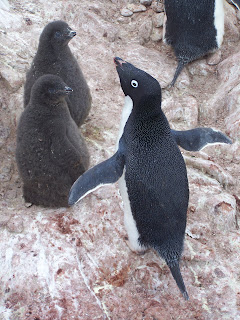
Antarctica, the land of penguins!
The Dumont d'Urville base was originally built, or at least a single shack was built on the Île des Pétrels, in order to study penguin colonies close up. And there is so much material to study!

How to describe a penguin....
Well, they are, constitutively, birds. And therefore, in my personal opinion, daft. Add to that the fact that they are water birds, and so are not naturally at ease on land. And add again to that the fact that they are colonial birds, and get easily stressed when alone.
What you get are large groups of birds that are absolutely hilarious any time they are on land, and that are pure grace and speed in the water. Well, most of the time in the water.
The small canal that separates DdU from the Lion is obscured for most of its length by ice coming from the continent's glaciers to the South, and the general water circulation causing ice to pile up on the Southern shore of the Lion. About half way up the Lion, the ice breaks off, to leave a small canal of open water, nicely protected from currents and winds. This is the penguin bathtub. And in there, gone is the grace of the swimming penguin, and inter the team of tuxedo-dressed un-synchronized swimmers!
We did not have much chance of seeing them actually fishing, but we did get to see the trail of bubbles they make. And also the exiting of the water. This is extremely impressive, as they shoot out of the water at high speed and can land on a ledge quite high off the water, and hardly ever fall over when landing. The water intering is also quite nice.

That, however, is the end of grace and elegance. Now on land, they find themselves with large feet, very short legs, and a tummy which prevents them from seeing where they're walking.
And here we come to a parting of the ways.
Although, while in the water, all penguins are penguins, on land that is not so. We arrived in January, so nearly all the emperor penguins had already left, leaving the island swarming with Adelie penguins. Emperor penguins are the largest of penguins, and take their royal status seriously. The press of duty seems to have made them somewhat depressed, as they will wander the ice, shoulder hunched and head hanging. And they make it perfectly clear that there can be no possible friendship with something as lowly as an Adelie penguin.
Emperor chicks with adult Adelie penguins.

This does not seem to over-affect the Adelie penguins, but then they seem constantly on the brink of total pandemonium, so it' s a bit hard to tell...
Adelie penguins. First of all, there is no such thing as ONE Adelie penguin. They get stressed when even at moderate distances from their folk, and will go berkers untill more arrive to see what all the fuss is about.
Adelie penguins are about half the size of the emperors, with a black head and back and a white belly. And they are rock penguins. As in they love rocks.
I am sure you all know about emperor penguins, and if not I recommend the movie March of the Penguins (which is fake and anthropomorphic and all, but nice anyway). Adelie penguins are not at all the same. As I said, they like rocks. So, as soon as they arrive on the island, up they go to the top, and start piling up pebbles to make a nest. Penguins return to where they were born, like salmons, and so the first arrived go back to their old nests, and take the opportunity to steal as many nice pebbles from the neighbouring nests as they can.
As the season progresses, the island slowly fills, untill the nests reach a couple dozen meters from the water's edge. There are usually 2 chicks, and they need feeding! And feeding means fishing, and fishing means you have to make your way down to the sea, which is now packed with penguins. And the penguins on the lower slopes, already slightly annoyed at having been stolen all the best pebbles, become downright furious at people 'passing through' their nesting area.
As one flipper flapped is more that enough to break the fragile barrier of silence and good manners, the whole area explodes onto a squalking, pecking and flipper beating mess. Multiply this by a couple hundred penguin nests, containing of 1 or 2 hungry and fast-growing chicks, needing feeding several times a day....
And, as everywhere, there never are never the same number of females and males. So, among the nests, are lone individuals. And their blood tells them they must find a mate. This is done by the process of finding an unclaimed pebble (for the males) and wandering around with it in their beaks to show it to every penguin they see. The females simply go and see every penguin they see. However, they seem to have a rather wide definition of penguin, or at least of 'possible mate'....
And now to close on penguins and their problems.
Probably the most anthropomorphic animals in the world, they will probably never cease to amuse and surprise, but there are penguins and penguins.
Emperors are regal, and take their duty seriously. They go from extremely sweet and well brought up chicks, to cute molting chicks, to regal poised adults.
Adelie penguins are not quite the beautiful birds you see in pictures. They are mostly noisy, smelly, dirty and frankly histerical. And the molting chicks are not the prettiest sight in the world.
One point on common, is that they're all daft. But then, aren't we?

































































